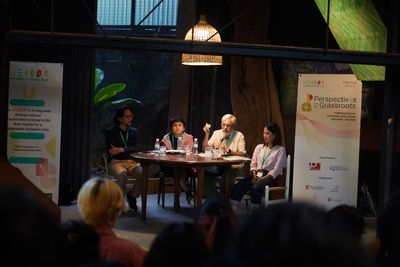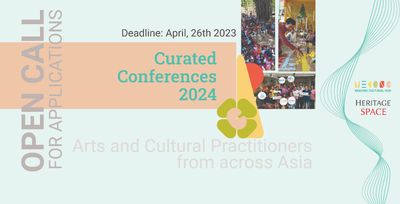Meeting: What's The Point?

Social change is often associated with generational shifts centered around the aspirations, energy, and drive of youths. Daniel Ho Sheng caught a glimpse of what was on the minds of younger participants at the 2024 edition of the Meeting Point on Art & Social Action in Asia, many of whom were attending a gathering like this for the very first time.
Art is a powerful tool for social action. It can challenge norms, foster empathy, and spark movements. Art can also serve as a wayfinding tool for uncovering challenges, reflecting on progress, and for charting a course toward a collective future we may not have yet envisioned.
The reality, however, is neither this straightforward nor this glamorous. Grassroots practitioners of art and culture, while privileged to be in the driver’s seat of such transformation, continue to find themselves surrounded by roadblocks, sometimes at tremendous personal cost.
For the seasoned, this may be par for the course, but for the starry-eyed greenhorn, it could be a dealbreaker. While social change is often associated with generational shifts centered around the aspirations, energy, and drive of youths, it operates within a broader ecosystem of intergenerational considerations, political and institutional dynamics, civil society organisations, and cultural influences.
Enter Meeting Point
The 2024 Meeting Point on Art & Social Action, organised by Mekong Cultural Hub and themed “Perspectives from the Grassroots”, shed light on some of these issues that practitioners are grappling with today, and sought to make spaces for dialogues with policymakers and researchers. It gave a platform to the short-term and long-term perspectives that practitioners see for themselves and for the arts in Asia, and to discuss how more space can be created for not just thinking ahead, but for working together and making the progress needed to get there.
While now in its third run, this was Meeting Point’s first time with an in-person finale, a culmination of a series of online events and local gatherings, bringing together over 120 practitioners, working at the intersections of art and society, from over 20 countries in Asia and beyond. That many of the participants had already begun working with or engaging one another in the months leading up to the finale gave rise to a palpable pulse of excitement as they got to further their conversations with one another throughout the three-day event.
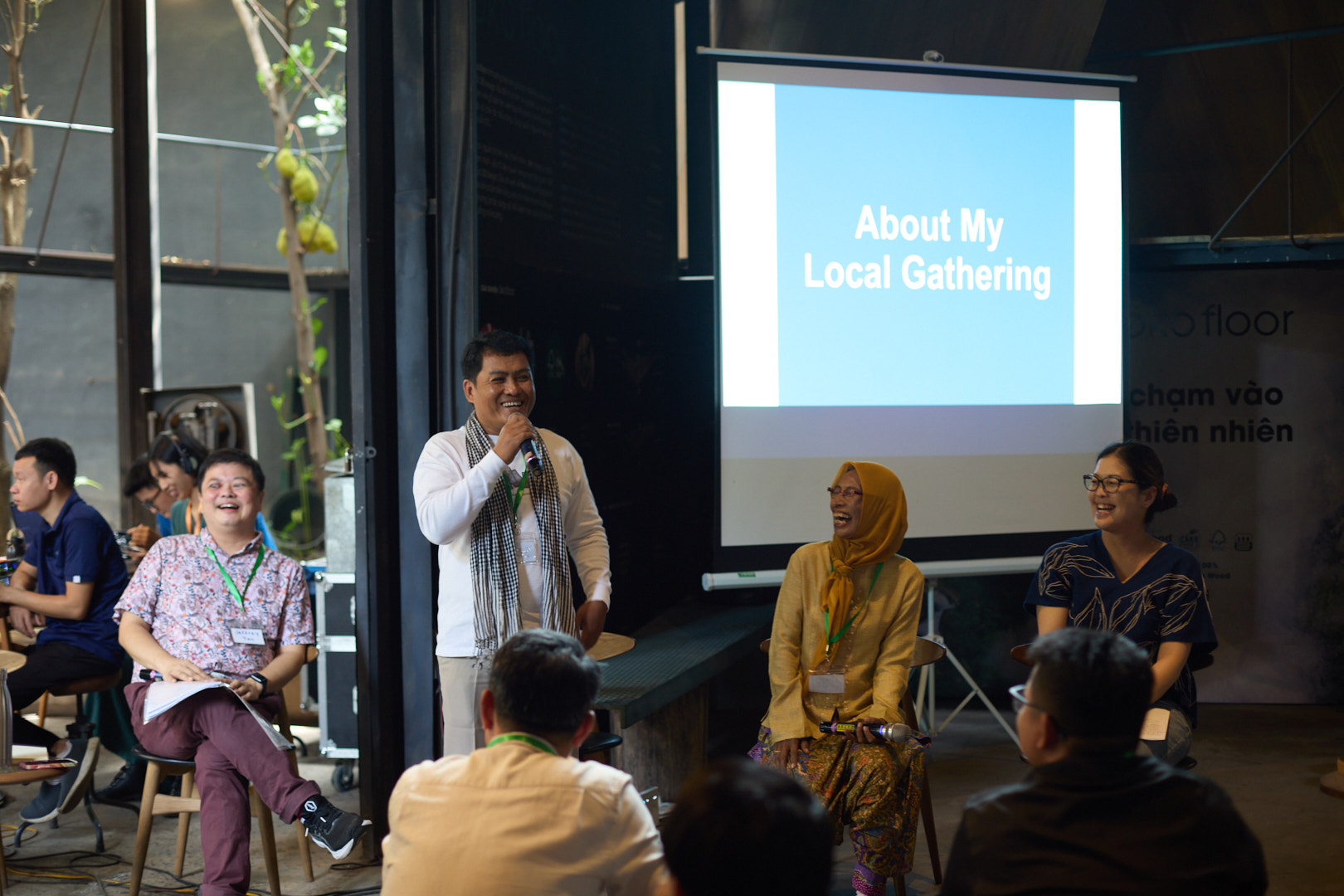
1. Before the conference, nine artists organised their own workshops and small confeences, also known as 'Local Gatherings', in their respective countries. The group presented some of their highlights at Meeting Point © Mr. Hoang Nguyen and Ms. Ngo Tran Phuong Uyen.
Questions of purpose and sustainability took centrestage, as one can expect of a conversation on grassroots movements, and even more so one involving art and culture workers, in a region of the world where the ecosystem is perceived to be severely underrepresented, undersupported, and underdeveloped.
What was far less expected, however, was the diversity of the crowd, not just in nationality and practice but also in age. I have participated in various cultural meetings and events over the years, but Meeting Point 2024 was the first where I clearly was not the youngest.
Refreshing and much-needed, if you ask me.
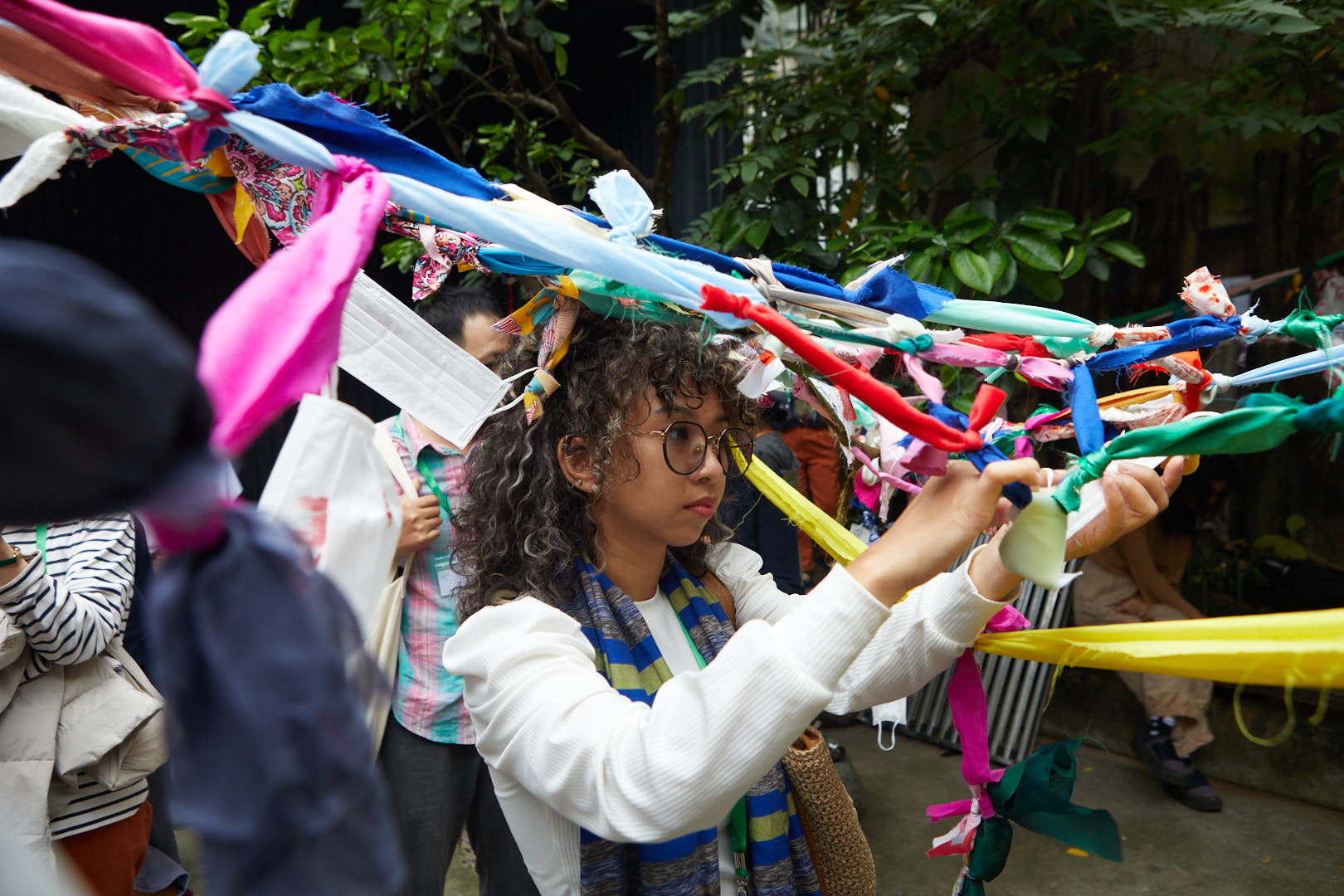
2. In the session 'grassroots whispers & whistles,' Meeting Point participants were invited to take part in guided actions - using art, creativity, physical action, and emotional sensing - to approach the theme of 'Perspectives from the Grassroots' differently © Mr. Hoang Nguyen and Ms. Ngo Tran Phuong Uyen.
Discovery and connection
The prospect of finding a personal and collective breakthrough motivated Hoai Thu (Thou), 24, a budding artist and writer, to bootstrap her journey from Ho Chi Minh City to Hanoi.
“I decided to participate in Meeting Point because it addresses many of the things I care about: social change from the grassroots, the diversity of practice in the Mekong delta, the current context of the arts in our region, and how arts practitioners like me can get connected to that network.”
For Nguyen Thanh Phuong, a 26-year-old theatre and performing arts practitioner from Viet Nam, attending a gathering like Meeting Point was a first.
“In my practice, my time has mostly been spent working alone or with a very limited circle of close colleagues. I also find myself and many young artists in my country not fully aware of how to navigate various sensitivities.”
Similarly, it was 30-year-old Indonesian artist, curator, and producer Benny Widyo’s maiden experience travelling abroad for a regional gathering of fellow art and culture workers. He took part in the curated conference programme, a component of Meeting Point where selected Fellows engaged in monthly online exchanges for several months before sharing the outcomes of their discussions at the in-person gathering.
There were two topics for this year’s curated conference programme: 1) Life Cycles of Grassroots Cultural Organisations in Asia, curated by Phloeun Prim (Cambodia), and 2) Hitting Pause: Examining Purpose & Practice, curated by Kathy Rowland, Arts Equator (Malaysia/ Singapore).
“Initially, I wasn't sure. However, I decided to participate in a curated conference session and, after several months of virtual meetings with my group, I finally had the opportunity to meet them and other art practitioners in person,” said Benny.
And for Singaporean arts manager Olivia Tay who, like Benny, also participated in the curated conference programme, Meeting Point was an opportunity for escape and rediscovery.
“Coming from a more bureaucratic, rigid arts landscape, I saw Meeting Point as an opportunity to expose myself to different mindsets and ways of working. I hoped the new environment would open up creative pathways and help me learn how to better facilitate change, understanding and growth - both within my own organisation and the larger cultural community.”
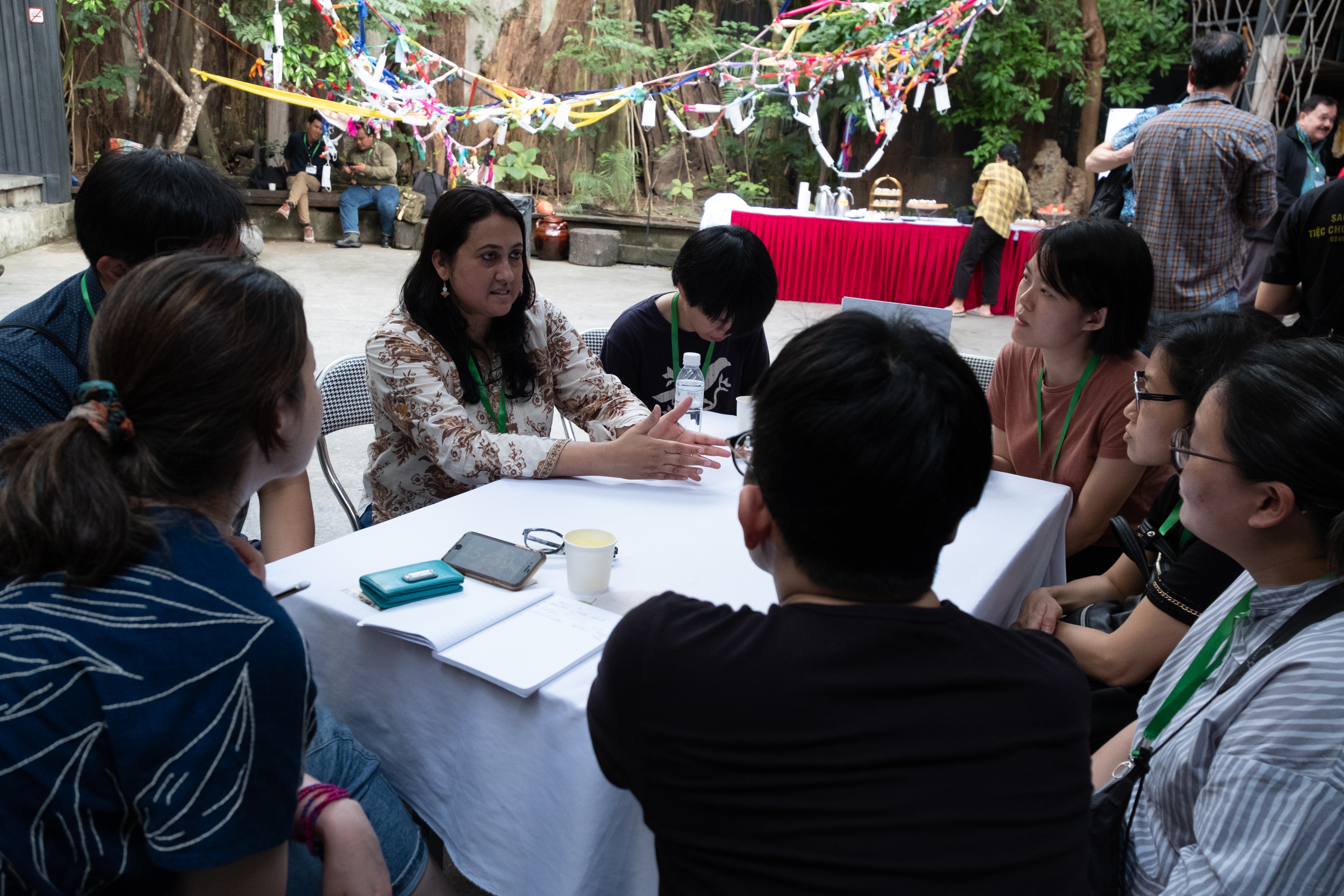
3. During breaks, participants could traverse various installations and take a deeper dive into some of the issues, findings, and reflections, and expressions of the various projects and sessions © Mr. Hoang Nguyen and Ms. Ngo Tran Phuong Uyen.
Desire for responsible change
Curious about the arts scene in Thou’s, Phuong’s, Benny’s, and Olivia’s respective countries of origin, and whether their posture towards Meeting Point might be shaped by specific contextual factors, I asked about the issues surrounding young artists and arts workers in creating social change.
Half-expecting our young friends to seize this opportunity to dish out frustrated criticism towards institutions and bureaucracy, I was pleasantly surprised by their measuredness, thoughtfulness, and patient optimism, even as they shared a common dissatisfaction of the status quo and a strong desire for change.
Thou: “As society increasingly seeks the arts, it is important that young artists know what we can do and what we shouldn’t do in order to be safe. The roles and responsibilities of artists in our contemporary context need to be better-defined, as this will shape our artistic works and match our practice with our contribution to the community we are living in.”
For Benny, it is structural issues, such as mobility, inequality, centralisation, and generational sentiments that continue to present challenges for artists and arts workers in Indonesia.
“Achieving equity solely through the central government is challenging. However, local governments can play a crucial role in filling this gap. They are better equipped to reach their respective areas, as it is physically easier for them to meet and present the possibility of development starting on a more manageable scale.”
He is cautiously optimistic, however, that things are starting to move in a positive direction: “These challenges are starting to diminish due to the dispersed and networked movement. It just requires more time and effort to make it more inclusive and evenly distributed.”
Olivia pinpointed practical, operating realities facing the arts community in Singapore.
“Addressing systemic challenges around funding, pay equity, and healthy work environments is key. Too often, people and funders are eager to support specific programmes and projects, but neglect the core operational funding that enables organisations to function. By investing in the people that underpin Singapore's vibrant cultural landscape, we can truly develop the next generation of arts leaders.”
She hopes that policymakers in Singapore can recognise the arts as a crucial public good that deserves robust, reliable investment: “Arts and culture don't just enrich individual lives - they strengthen the fabric of society as a whole.” She also hopes that the general public will continue to engage with, support, and appreciate the arts, by attending performances, visiting exhibits, participating in workshops, and continuing to champion the arts and artists that inspire them.
Phuong’s simple but wise advice? “I hope my arts peers keep a cool head and a warm heart.”
Realisations and takeaways
Hearing how her peers navigated analogous issues and coming together with them to explore solutions provided Olivia a sense of camaraderie and shared purpose. She realised how the arts community across Southeast Asia is grappling with remarkably similar structural, organisational, and societal challenges.
She found herself developing a more flexible and expansive worldview that she was eager to take back to her organisation and her community back home.
“The conference exposed me to opportunities beyond my immediate local context. Connecting with arts practitioners from across Southeast Asia and even further afield opened my eyes to the diverse array of initiatives, networks, and resources available to young arts workers like me. I'm energised by the prospect of exploring these possibilities for cross-cultural exchange, joint projects, and mutual support systems.”
Benny echoes this sentiment while offering a dose of realism: “We talked about our activities, the challenges we faced, and the struggles we encountered. We shared knowledge and experience within our immediate context, but with the intention for it to be collaborative. Some information can be applied right away, while some call for further reflection.”
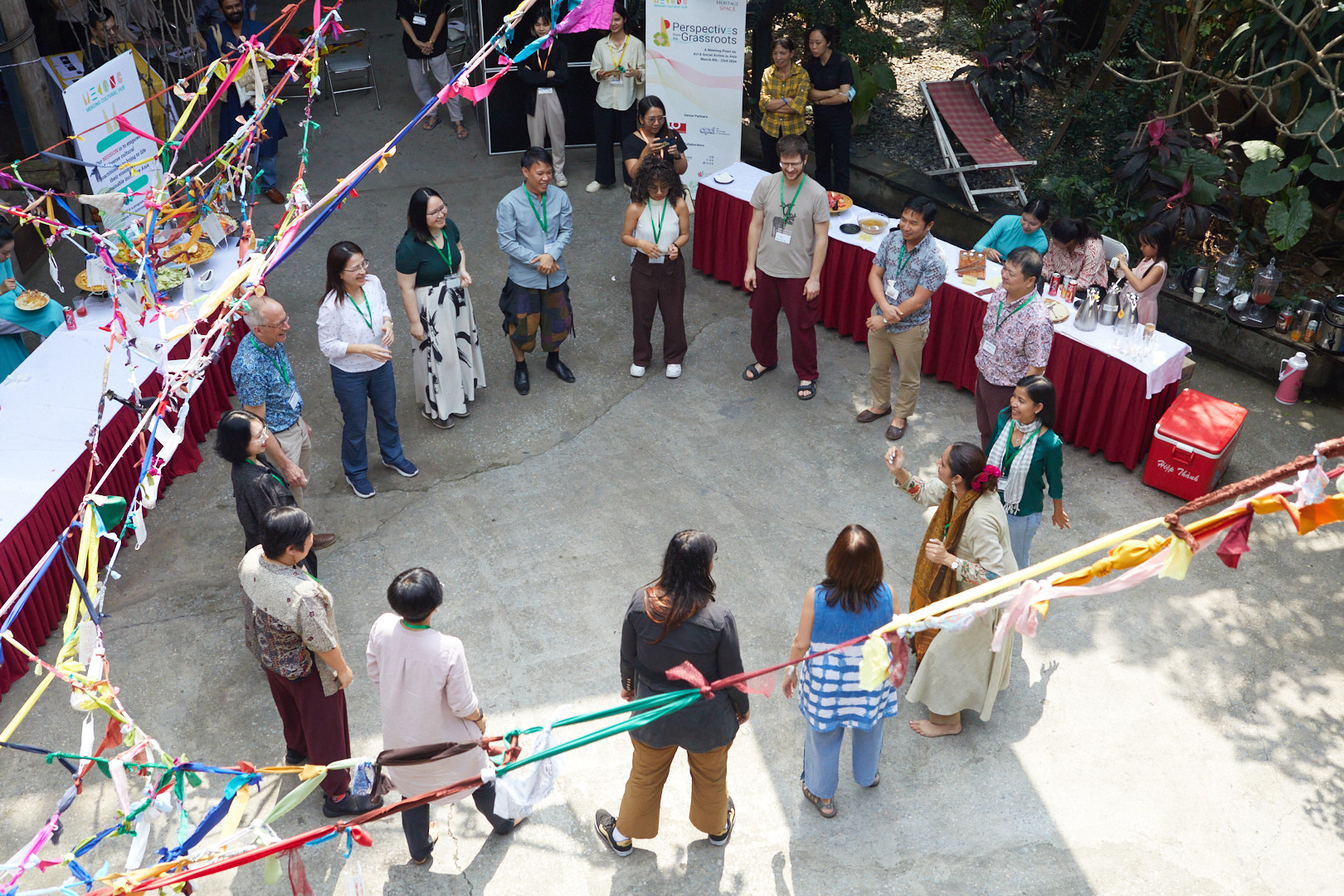
4. Can drama conventions facilitate equal dialogue paces and trust-building? Participants got a glimpse into the application of art-based pedagogy in Indian classrooms, in this session prompting cross-cultural understanding through theatre-in-education © Mr. Hoang Nguyen and Ms. Ngo Tran Phuong Uyen.
Collaboration and creation
Transfer of knowledge and understanding aside, what many of the younger participants seemed to look forward to the most is what comes next.
“As someone young and just taking my first steps into arts practice, the process of heritage and knowledge-sharing means a lot to me. Even though it was my first time participating in such a gathering, I did not feel overlooked. I believe it is the premise for us to have more international collaboration and support in the future,” Phuong says.
What comes next, though, isn’t so clear.
Thou suggests that follow-up is needed: “I hope there can be further discussion on how Meeting Point can give birth to some collaborative projects that we can work together on, and how it can mobilise more support for young artists in the Mekong delta.”
Thou also identified contextual differences and disparities that call for flexibility and agility.
“It is important to gather people from different quarters of the arts landscape and let them have conversations with one another about how we can work together to create an ecosystem for arts development in the region. However, every local context requires a specific practice and things take time to be done correctly. Mistakes will be made along the way so we need to be flexible with our creative approaches and be agile with the changes.”

5. More magical moments between artist and audience, in the experiential session 'grassroots whispers and whistles'. How can this spirit of co-creation be made more present in our professional lives? © Mr. Hoang Nguyen and Ms. Ngo Tran Phuong Uyen.
The point of meeting
Did Meeting Point succeed in shifting the needle? Only time will tell.
“I was reminded that the journey is often more important than the destination,” says Olivia.
“The curated conference sessions emphasised that the creative process and collective problem-solving don't always lead to perfect, polished outcomes. Sometimes, it's okay to embrace imperfection and focus on learning from the messiness of real-time collaboration. This mindset shift was freeing and encouraged me to be more experimental in my own practice.”
One thing’s for sure - it has to start somewhere. As Benny candidly quips, “The most important aspect, I believe, is the meeting itself.”
It’s now up to each of us to make the most of it.
Cover Image: Meeting Point 2024 © Mr. Hoang Nguyen and Ms. Ngo Tran Phuong Uyen
About the Author
Daniel Ho Sheng is the Deputy COO of Singapore-based, youth-focused media company Mothership, and a board member of animal welfare group SPCA Singapore. He had previous stints with the Culture Department of the Asia-Europe Foundation, first as an intern and later as an independent consultant.
Similar content
posted on
posted on
posted on
posted on
